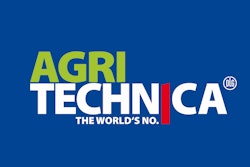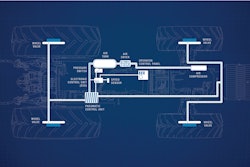In order to continue to offer professional agricultural enterprises highly efficient, powerful agricultural machinery, AGCO/Fendt has optimized and further developed its product portfolio. At Agritechnica 2013, the agricultural equipment manufacturer presented its innovations to the public for the first time.
Fendt 800 Vario
In face of the continually climbing demands on agricultural companies, AGCO/Fendt has decided to further optimize its flagship 800 and 900 tractor series. In doing so, the agricultural equipment manufacturer has placed special emphasis on comprehensive driving safety and dynamics. The precisely coordinated drivetrain, increased driving and braking stability, further optimized steering behavior and the numerous assist and safety systems make work easier for operators of the new Fendt 800 and 900 tractor series and impart a completely new driving sensation.
Thanks to two different-sized turbochargers, which are connected in series, as well as an additional charge-air intercooler, the new six-cylinder engines deliver impressive dynamics, robustness and efficiency. Twin charging optimizes power output and fuel consumption in the low speed range. The cooling effect of the additional intercooler ensures improved combustion and fuel efficiency. The best overall concept includes sophisticated engine and transmission oil cooling systems as well as one-part steel pistons, which promise maximum stability and durability.
With the new Fendt 800 Vario and 900 Vario tractors, AGCO/Fendt offers tractors that comply with the Stage IV/Tier 4 Final emissions standards, which go into effect in January 2014. For this the agricultural equipment manufacturer has further developed the SCR technology, where exhaust is after-treated with AdBlue urea solution, with the addition of a passive particulate filter and exhaust gas recirculation. In combination with the sophisticated engine technology, Fendt SCR with passive diesel particulate filter (DPF) offers a technically high-grade and efficient, fuel-saving solution, where the passive regeneration is carried out without requiring an additional injection of fuel into the exhaust line. Compared with the other two systems available on the market, SCR and active DPF and SCR only, which also comply with the EU Stage IV/Tier 4 Final emissions standards, this technology permits the lowest overall operating costs. The increased engine cooling capacity and a lower rated speed of 2,100 rpm (900 Vario) together with the map-controlled AdBlue injection, also play their part in reducing fuel and AdBlue consumption. Additionally, this technology has outstanding environmental-compatibility with a 90% reduction in particulate matter and nitrogen oxides.
The new Fendt tractors have a ground-breaking, efficient overall design concept comprising numerous optimally coordinated individual measures – exactly 63 individual measures for the 900 Vario and 54 for the 800 Vario. The new high-horsepower tractors from the 800 Series score with their compact dimensions, flexibility and performance. With up to 280 hp, they are not only powerful in the field, but also superior for transport work. The new Fendt tractors from the 900 Series deliver bundled expertise in power transmission, electronics, efficiency and robustness. Through new and unique technologies, the 900 Vario can do more and does it better. The new Fendt 800 Vario and 900 Vario tractors are also superior in the details, featuring intelligent and efficiency-enhancing technologies such as the VarioGrip tyre pressure regulation system, automated steering, fuel pre-filter, coming home light and much more.
The new Fendt X and P-Series combines
With the combines available for the harvesting season 2014, the new X-Series (9490 X/AL) and new P-Series (8380 P/AL, 8410 P/AL), AGCO/Fendt offers a selection of high-output combines for farming enterprises that require power, reliability and the highest level of technology. The combines from the Fendt X and P-Series are the first combines available on the market for purchase with engines that comply with Stage IV/Tier 4 Final emissions standards. Equipped with six and seven-cylinder engines from AGCO Power and four-valve technology, they deliver a maximum output of up to 379 hp (8,380 P/AL), 404 hp (8410 P/AL) or 496 hp (9490 X/AL). The combines are fitted with a grain tank with a capacity of 12,500 L (8410 P, 9490 X) or 10,500 L (8380 P, all AL models). The Fendt PowerFlow table offers working widths of up to 10.70 m for the X-Series and up to 9.20 m for the P-Series.
To guarantee an optimal, constant output on slopes, the AutoLevel models in the P-Series 8340 P/AL and 8410 P/AL, and the X-Series 9490 X/AL are equipped with the well-known pivoting axle portals on the AutoLevel front axle and enable compensation for slopes up to 12%.
The design of the operator environment is decisive for getting the best performance out of the machine. The new, generously sized Skyline cab, already found in the Fendt C-Series combines, offers plenty of space and guarantees exceptional visibility to the most important areas of the combine, such as the unloading tube, stubble and table. The Fendt combines are equipped with the latest generation of comfort seats.
The Varioterminal, featuring a large touchscreen color display (10.4 in.), offers maximum convenience for operating and monitoring the machine. It displays all relevant performance data and settings of the Fendt combine. It is integrated in and adjusts with the armrest to prevent relative movement between the operator and the terminal. The terminal can be operated with the touchscreen or the keys and rotary control. Operators can quickly and intuitively change the machine settings with the Varioterminal or by using the switches in the armrest. For example, the sieves can be electrically adjusted from the cab. The central control element for the Fendt combine lies securely in the hand. The Fendt multi-function joystick in located in the front part of the Variotronic armrest and contains all the buttons required for controlling all of the most important areas of the machine for the harvest.
The Varioterminal can save up to three machine settings for all of the major types of crops. One click on the saved setting and the machine automatically adopts the settings and then, for example, accordingly adjusts the threshing cylinder speed or concave setting.
Fendt optimizes its square baler line
AGCO/Fendt has reworked and updated its square baler line. The six models, 870, 990, 1270, 1290, 1290 XD and 12130, now offer optimized operating and maintenance-friendliness with improved quality and reliability. Connected with this is a higher output as well as savings in time, fuel and costs.
The new Fendt Katana 85 forage harvester
Building on the proven technology of the Katana 65 forage harvester, which was launched last year, AGCO/Fendt now presents the Katana 85 forage harvester with 850 hp at the Agritechnica 2013. The Fendt Katana 85 is powered by a 21-liter V12 MTU engine, which is equipped with a larger radiator than the Katana 65 for a higher cooling capacity. For higher ground clearance and more traction, larger tires are available for the Katana 85 than the Katana 65. Based on a new fuel tank concept, users can choose between two tank variants. The first variant is exclusively for 1,500 L of diesel. In the second variant, the tank is divided into two chambers: one for 1,250 L of fuel, the other for 250 L of water for the silage additive.
The Fendt X Concept
AGCO/Fendt has many years of research experience in the area of electric drives for tractors. At Agritechnica 2013, the agricultural equipment company presented its first research results from the Fendt X Concept project. A Fendt 722 Vario, which now has a high-voltage interface in addition to the hydraulic connections and the PTO. Up to 130 kW electrical power is available here to operate electrified implements. These implements are controlled with the well-established ISOBUS.

















